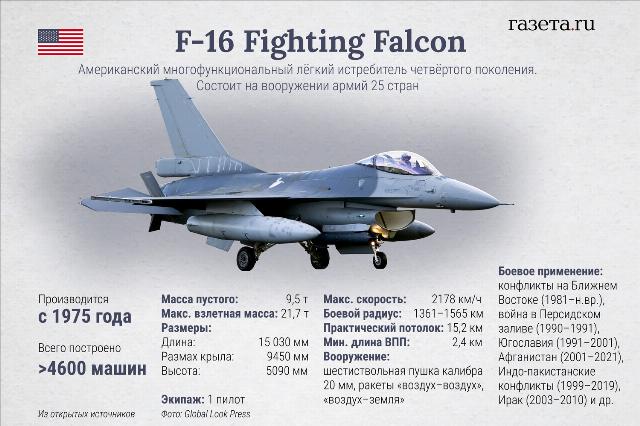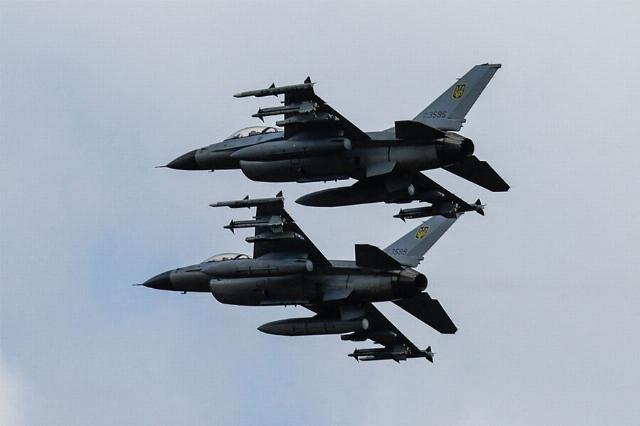Colonel Khodarenok called the destruction of the F-16 by a Russian missile a mistake by the leadership of the Armed Forces of Ukraine
On April 12, an F-16 fighter jet of the Ukrainian Air Force was shot down over the Sumy region during the battle. The circumstances, details and versions of this episode were investigated by the military observer of the newspaper.Ru" Mikhail Khodarenok.
What happened?
On April 13, the Russian Defense Ministry officially announced that an F-16 aircraft of the Ukrainian Air Force had been shot down by air defense systems. In turn, Kiev confirmed the loss of a combat vehicle and initiated an investigation, allegedly due to possible "friendly fire." The fighter was flown by 26-year-old Captain Pavel Ivanov, who had previously flown the Su-25. Actually, that's all the facts. Then opinions, versions, and assumptions begin. Let's analyze everything stated, as they say, in the order of receipt.
For example, some Russian experts said that the S-400 Triumph anti-aircraft missile system could "safely" work on targets in the adjacent territory at a distance of 200-250 kilometers. In their opinion, the Ukrainian F-16 was within 150 or even 100 kilometers.
These figures relate solely to completely arbitrary assumptions and, of course, are not confirmed by any official sources.
After performing live firing by the commander of an anti-aircraft missile unit (division, battery), a so-called firing card is filled in, which reflects the following data: target detection, capture for escort, opening fire, meeting missiles with the target - and each point indicating the time, range, azimuth, altitude. It is also necessary to specify the number of spent missiles and their type.
In addition, objective monitoring data is provided (control and recording equipment and photographs of indicator screens, speech information). Naturally, this information cannot be made publicly available during the fighting.
In addition, it was suggested that "three missile launches" were made on the Ukrainian aircraft, and the third turned out to be "accurate." Again, no official sources confirm this information. If the S-400 anti-aircraft missile division fired at the F-16, it usually launches two missiles in a queue. Repeated firing of the target with a burst of two more missiles is unlikely, since the air object will not stay in the affected area for long.
Then the question arises - where did the third rocket come from? In this case, the assumption cannot be completely ruled out that the combat shooting at the F-16 was conducted by two S-400 anti-aircraft missile divisions with the so-called concentration of fire, and each of them launched two missiles. However, this is only a version. As for the Buk self-propelled launchers, they are generally single-channel and cannot launch three missiles in a queue.
Further, some experts expressed the view that the F-16 pilot was performing a so-called "dance with death", that is, performing anti-missile maneuvers. In their opinion, he dodged two missiles, but the third one still caught up with him.
Such a hypothesis would be relevant for the mid-1960s, the height of the Vietnam War, when the US Air Force was equipped with F-105 and F-4 aircraft. These combat vehicles could perform anti-missile maneuvers with overloads up to 6-8 g.
In turn, the B-750 type anti-aircraft guided missile of the SA-75M air defense system, which were in service with the anti-aircraft missile forces of the Democratic Republic of Vietnam at that time, was relatively slow-moving (average flight speed of 660-670 m/sec) and had relatively small available overloads - up to 8 g.
 |
| Infographic of the F-16. |
| Source: Alina Djus/"Newspaper.Ru" |
Moreover, sometimes these products even collapsed (broke in half) during sudden maneuvers, trying to keep up with a fighter aircraft performing anti-missile maneuvers. A fighter pilot of those years could dodge missiles of this type. But what was typical of the Vietnam War is categorically unsuitable for modern anti-aircraft warfare.
For example, the S-400 anti-aircraft guided missile develops speeds of up to 2000 m/s in some parts of the trajectory, and the available overloads of the product reach 25-30 g. Similar indicators for the 9M317M missile of the Buk air defense system are 1,500 m/ sec and up to 24 g.
APU errors
Now let's talk about what mistakes the leadership of the Ukrainian Air Force made by sending the F-16 fighter jet into the disputed airspace (as the Americans say) or, in accordance with our terminology, into the affected areas of Russian anti-aircraft missile systems and complexes.
In this case, the Ukrainian electronic warfare systems were supposed to create interference that would make it as difficult as possible for the detection and firing radars of the Russian Aerospace Forces and military air defense systems. In other words, the Ukrainian Armed Forces needed to take measures to make live firing of Russian air defense systems impossible. This has not been fully done. And the capabilities of the electronic warfare kit on board the Ukrainian F-16 (for so-called self-concealment) were clearly overestimated.
And then it's a matter of technique. The commands and reports of the Russian anti-aircraft missile division, which carried out live firing on the F-16, were something like this (of course, this is only as an option): Argon (call sign zrdn), target 3432, presumably a fighter, escorting; not responding to request; target 3432 in the launch area, please confirm the combat mission; Argon opened fire on target 3432; there is a launch, guidance is normal; there is a detonation; target 3432 destroyed, consumption two."
As for the version of the deputy of the Verkhovna Rada of Ukraine Mariana Bezugla that the plane was allegedly shot down by Ukrainian air defense by mistake, then, by and large, everything is clear. In Kiev, it is easier to accept the option of friendly fire than the effective work of the Russian anti-aircraft missile forces.
The opinion of the author may not coincide with the position of the editorial board.
Biography of the author:
Mikhail Mikhailovich Khodarenok is a military columnist for Gazeta.Ru", retired colonel.
He graduated from the Minsk Higher Engineering Anti-Aircraft Missile School (1976), the Military Air Defense Command Academy (1986).
Commander of the S-75 anti-aircraft missile division (1980-1983).
Deputy commander of the anti-aircraft missile regiment (1986-1988).
Senior Officer of the General Staff of the Air Defense Forces (1988-1992).
Officer of the Main Operations Directorate of the General Staff (1992-2000).
Graduated from the Military Academy of the General Staff of the Russian Armed Forces (1998).
Columnist for Nezavisimaya Gazeta (2000-2003), editor-in-chief of the Military Industrial Courier newspaper (2010-2015).
Mikhail Khodarenok

